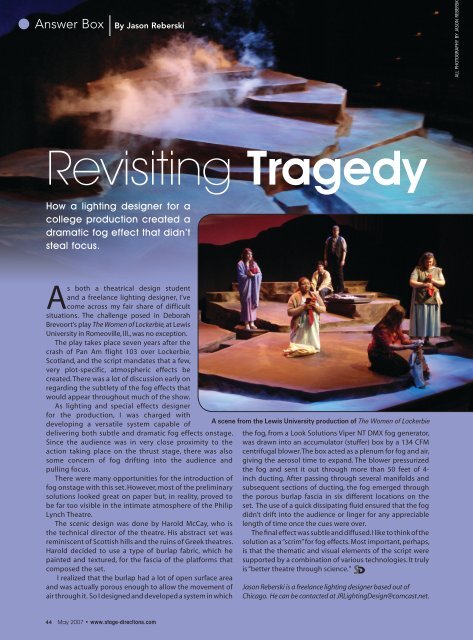May Issue - Stage Directions Magazine
May Issue - Stage Directions Magazine
May Issue - Stage Directions Magazine
You also want an ePaper? Increase the reach of your titles
YUMPU automatically turns print PDFs into web optimized ePapers that Google loves.
Answer Box<br />
By Jason Reberski<br />
All photography by Jason Rebersk<br />
Revisiting Tragedy<br />
How a lighting designer for a<br />
college production created a<br />
dramatic fog effect that didn’t<br />
steal focus.<br />
As both a theatrical design student<br />
and a freelance lighting designer, I’ve<br />
come across my fair share of difficult<br />
situations. The challenge posed in Deborah<br />
Brevoort’s play The Women of Lockerbie, at Lewis<br />
University in Romeoville, Ill., was no exception.<br />
The play takes place seven years after the<br />
crash of Pan Am flight 103 over Lockerbie,<br />
Scotland, and the script mandates that a few,<br />
very plot-specific, atmospheric effects be<br />
created. There was a lot of discussion early on<br />
regarding the subtlety of the fog effects that<br />
would appear throughout much of the show.<br />
As lighting and special effects designer<br />
for the production, I was charged with<br />
developing a versatile system capable of<br />
delivering both subtle and dramatic fog effects onstage.<br />
Since the audience was in very close proximity to the<br />
action taking place on the thrust stage, there was also<br />
some concern of fog drifting into the audience and<br />
pulling focus.<br />
There were many opportunities for the introduction of<br />
fog onstage with this set. However, most of the preliminary<br />
solutions looked great on paper but, in reality, proved to<br />
be far too visible in the intimate atmosphere of the Philip<br />
Lynch Theatre.<br />
The scenic design was done by Harold McCay, who is<br />
the technical director of the theatre. His abstract set was<br />
reminiscent of Scottish hills and the ruins of Greek theatres.<br />
Harold decided to use a type of burlap fabric, which he<br />
painted and textured, for the fascia of the platforms that<br />
composed the set.<br />
I realized that the burlap had a lot of open surface area<br />
and was actually porous enough to allow the movement of<br />
air through it. So I designed and developed a system in which<br />
A scene from the Lewis University production of The Women of Lockerbie<br />
the fog, from a Look Solutions Viper NT DMX fog generator,<br />
was drawn into an accumulator (stuffer) box by a 134 CFM<br />
centrifugal blower. The box acted as a plenum for fog and air,<br />
giving the aerosol time to expand. The blower pressurized<br />
the fog and sent it out through more than 50 feet of 4-<br />
inch ducting. After passing through several manifolds and<br />
subsequent sections of ducting, the fog emerged through<br />
the porous burlap fascia in six different locations on the<br />
set. The use of a quick dissipating fluid ensured that the fog<br />
didn’t drift into the audience or linger for any appreciable<br />
length of time once the cues were over.<br />
The final effect was subtle and diffused. I like to think of the<br />
solution as a “scrim” for fog effects. Most important, perhaps,<br />
is that the thematic and visual elements of the script were<br />
supported by a combination of various technologies. It truly<br />
is “better theatre through science.”<br />
Jason Reberski is a freelance lighting designer based out of<br />
Chicago. He can be contacted at JRLightingDesign@comcast.net.<br />
44 <strong>May</strong> 2007 • www.stage-directions.com

















